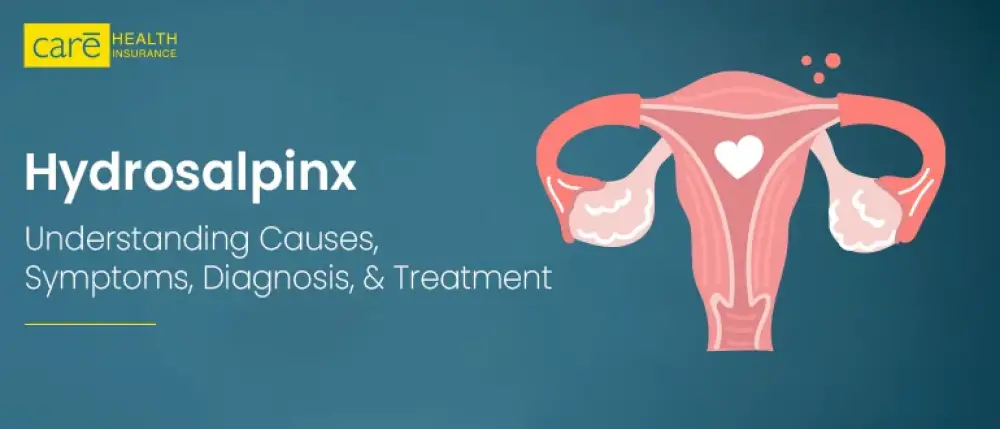Subscribe to get weekly insights
Always stay up to date with our newest articles sent direct to your inbox
Published on 21 Oct, 2024
Updated on 18 Feb, 2025
3144 Views
5 min Read

Written by Riya Lohia
favorite2Likes
Hydrosalpinx is a medical condition that affects the fallopian tubes in women, where one or both tubes become blocked and filled with a watery fluid. This condition can lead to infertility, discomfort, and other complications, making it a significant concern for many women of reproductive age. Hydrosalpinx often remains unnoticed until a woman experiences difficulty conceiving or other related symptoms. In this article, we will explore the causes, symptoms, diagnosis, and treatment of hydrosalpinx, offering a human-centered understanding of this condition.
The fallopian tubes are essential parts of the female reproductive system, playing a critical role in the journey of the egg from the ovaries to the uterus. When a blockage occurs within the tube and fluid accumulates, it leads to a condition called hydrosalpinx. The word "hydrosalpinx" comes from Greek, with “hydro” meaning water and “salpinx” referring to the fallopian tube. The fluid that builds up in the tube is typically clear or slightly colored, but its accumulation can interfere with normal reproductive functions.
Hydrosalpinx usually develops as a result of inflammation or infection within the fallopian tubes. Several underlying causes can trigger this blockage:
In many cases, hydrosalpinx does not cause noticeable symptoms, making it challenging to detect early. Some women may not realize they have the condition until they struggle with fertility or undergo testing for other reproductive health issues. However, in some cases, women may experience the following blocked fallopian tubes symptoms:
Diagnosing hydrosalpinx typically involves a combination of medical history, physical examinations, and imaging tests to confirm the presence of fluid-filled tubes. Some of the most common diagnostic methods include:
The treatment of hydrosalpinx depends on various factors, including the severity of the condition, the patient’s desire for future pregnancies, and the underlying cause. Here are the common fallopian tube blockage treatment options:
Hydrosalpinx is a condition that can silently affect a woman’s reproductive health, often leading to infertility or pelvic discomfort. Its underlying causes, such as infections or previous surgeries, make it essential for women to be aware of their reproductive health and seek timely medical advice. Fortunately, with modern diagnostic tools and treatment options like surgery and IVF, women with hydrosalpinx have a good chance of managing the condition and achieving their reproductive goals. If you are experiencing any symptoms or are concerned about fertility, consulting with a healthcare provider is the first step toward finding the right solution. Also, medical emergencies can occur anytime, anywhere and to anyone, irrespective of age. Hence, investing in a comprehensive health insurance plan that matches your medical needs is crucial. We at Care Health Insurance provide 360 degree coverage for your family protecting from both the predictable and unpredictable dangers of life.
Ultimately, by understanding hydrosalpinx, its causes, symptoms, and treatment, women can take proactive measures to protect their reproductive health and make informed decisions about their care.
>> Also Read: Health Insurance for IVF Treatment
Disclaimer: The above information is for reference purposes only. Kindly consult your general physician for verified medical advice. The health insurance benefits are subject to policy terms and conditions. Refer to your policy documents for more information.
शुगर कंट्रोल कैसे करे? जानें, डायबिटीज में क्या खाना चाहिए Care Health Insurance in Health & Wellness
Thyroid : मामूली नहीं हैं महिलाओं में थायराइड होना, जानें इसके लक्षण और घरेलू उपचार Care Health Insurance in Diseases
हाई ब्लड प्रेशर को तुरंत कंट्रोल कैसे करें? देखें इसके उपाय Care Health Insurance in Diseases
प्लेटलेट्स की कमी के लक्षण, कारण और इलाज क्या है Care Health Insurance in Diseases
What is IBS? Signs, Triggers & Solutions that Work Care Health Insurance in Diseases
What is Endocrinology? Hormones, Disorders & Treatment Care Health Insurance in Diseases
Do People with Mental Illness Have Less Heart Disease? Care Health Insurance in Diseases
एक्जिमा क्या है? देखें, इसके लक्षण और इलाज Care Health Insurance in Diseases